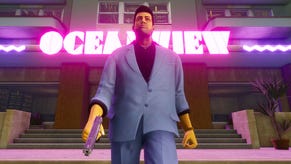GTA Definitive Edition: Vice City and San Andreas add to the disappointment
And the new patches do not address fundamental problems.
We've already looked at the opening entry in the Grand Theft Auto Trilogy Definitive Edition - and found the remastering to be anything other than definitive. Shoe-horning the RenderWare-based originals into Unreal Engine 4, presumably in order to tap into the modern technology's advanced rendering capabilities, delivers an experience that at its very best falls short. The mixture of old assets, AI upscaled textures, geometry-enhanced/smoothed vehicles, remodelled characters and modern rendering sensibilities is jarring to say the least. GTA3 was the oldest game and potentially showed off the biggest possible boost but what about Vice City and San Andreas? And what about the recently released patches - is the situation made any better?
Before we go into depth on the individual games, it's important to put the patches into context. Since they arrive relatively soon after the release of the trilogy, we should expect them to have been in development for some time - likely before launch, before the backlash. The patch notes suggest as much, ticking off fixes for a range of bugs as opposed to addressing the fundamental issues raised when the game launched. Our work on the games was mostly carried out on the unpatched launch code, but we've spent significant time re-examining the post-patch Vice City and San Andreas. Unfortunately, none of our issues with the game had been addressed and performance was also unchanged. Interestingly, there is a mention of improvements to the rain effect in San Andreas in the patch notes but even this seems to run in much the same way as before.
Looking at the trilogy as a whole, if there is one title that fares best, it's Vice City - perhaps because its original aesthetic is most 'compatible' with the new look of the Definitive Edition. There are broad similarities in colour schemes at least, so the often jarring look of the revised GTA3 and San Andreas isn't quite as upsetting in Vice City. However, the decision to move to UE4 and the way that transition was handled still presents the same inherent problems: the AI upscaling is often clumsy-looking, with physically-based materials producing a wildly inconsistent look and an odd 'plastic' aesthetic, to the point where even the sand on the beaches looks like a shiny, artificial surface. It's not a complete write-off though: the real-time lighting works, cube-mapped reflections on cars look fine, ambient occlusion is heavy but OK. Explosions are also a nice improvement.
However, this isn't to say that the game is worth buying, or that the developers made the right choices. Character rendering is exceptionally poor, just to take one example. The original Vice City had crude but expressive characters but they fit just fine into the overall look of the game. The new versions are rounded off with additional geometry, sporting physically-based materials which look bizarre with weird animation. There are all kinds of oddities here, from eyebrows that seem to move of their own accord to telephones that slide up and down as characters talk into them. The worst offenders are pedestrian NPCs, where stepped-up geometry doesn't seem to match up with animation rigging, resulting in esoteric alien-like creations.
But here's the thing - whether by accident or design, Vice City is indeed the best of the bunch. We weren't impressed with GTA3 but San Andreas is perhaps the most disappointing game in the pack. The original saw Rockstar pushing hard in all directions with the biggest open world the developer had created along with improvements to all areas of visual design and gameplay. San Andreas has a muted, yellowed look on original hardware, driven by the game's colour scheme and effects like heat shimmer and fog. It was still bound by technological limitations but Rockstar worked expertly within them and for its time, it was incredible.
All of the visual changes and compromises that blighted GTA3 and Vice City are still here in San Andreas but the key point is that the developer simply doesn't understand or seemingly pay much attention to the original design vision of the game. The core aesthetic is completely revamped, binned off in favour of something that simply doesn't look as good, as stylised or as impressive bearing in mind the host hardware. Yes, you do get the UE4 features like PBR materials, new dynamic lighting, modern reflections, new character models and ambient occlusion - but again, there is the same disconnect between old and new. It just doesn't work. On top of that, the apparent disregard for the original content leads to some really bad effects - for example, the lack of any atmospheric fog means that the entire world is visible from the air with nothing to obstruct your view or simulate distance, meaning no sense of depth to the world. Even the water cuts off at the horizon without any fading, giving the impression that the world just ends, that you're within the smallest of flat Earths. This is also an issue on the other remasters as well, but it's far more of a problem here, given the size of San Andreas's map and the large variety of aircraft the player pilots.
Somehow, character model rendering is even worse compared to Vice City - which probably isn't worth mentioning in too much depth as the various memes on social media have already highlighted the issue to brutal effect. However, the key point is that it's not just the misshapen NPCs that are the issue, but main characters too: Kendl is a higher poly remastered model, but all identity in the character is lost in the remastering process. This, combined with elements like the low poly Tuff Nut donut visual gag being fully rounded out simply suggest that there's a real problem here in understanding the basics of what this game is actually about. There are also basic comprehension issues too - such as upscaled textures now boasting spelling errors.
Performance-wise, for both of these games, not much has changed compared to Grand Theft Auto 3, which we've already looked at. On that title, we assessed every single console version of the game, on past and present generations. For Vice City and San Andreas, we limited ourselves to current-gen consoles only. Even so we're still looking at two games tested on four consoles, with fidelity and quality modes (or in the case of Switch, docked and mobile modes). These can all be slotted into three different visual quality tiers and they apply to every game in the pack.
At the top of the pile is PlayStation 5, Xbox Series X and Series S in quality mode - all targeting 30fps and suffering from inconsistent frame-pacing. Key visual upgrades here include improved shadow resolution, reflective puddles in rainy conditions and volumetric clouds. PlayStation 5's performance mode - oddly - includes all of the features of fidelity mode, just running with an unlocked frame-rate (which makes performance lower than Series X). Series S also sits in the top tier, but loses volumetric clouds. Middle tier versions deliver the base visual feature set, and that's what you get in Series X and Series S performance modes.
Meanwhile at the very bottom sits Nintendo Switch, which loses higher resolution art, motion blur, shadows under point lights, higher quality water rendering, ambient occlusion and interior mapping for some rooms behind windows. On top of that, draw distance is also reined in. The loss of AO and pared back shadows means that nothing looks connected to the ground any more and with that in mind, there's a genuine argument that the PS2 original looks better than Switch, which had sprite-based shadows located under characters and vehicles that at least tried to ground these elements into the scene. Performance on Switch is routinely abysmal, with low resolutions combined with frame-rates often in the low 20s and incorrect frame-pacing if you do hit 30fps. It's really disappointing.
Sticking with performance, Series X in performance mode has the best chance of hitting 60fps locked, but still has some lurching drops, even though it's only targeting 1800p. It's the same with PS5, which suffers even more in performance mode owing to its use of the top-tier visual feature set. Series S, meanwhile, aims for 1080p in its high frame-rate mode and runs much the same as Series X. Looking at the quality modes, Series S moves up to 1440p while PS5 and Series X remain at 1800p - however, the 30fps cap is poorly implemented with frequent stutter via inconsistent frame-pacing. The startling reality is that no version of GTA Definitive Edition runs smoothly in either 30fps or 60fps modes - unless you run PS4 Pro code on PS5, and take a big, big resolution hit in doing so. It's just nowhere near good enough.
Ultimately, you can't help but wonder about what might have been. These remasters are based on already compromised mobile ports that always had issues and already deviated too far from the source material. Rather than going back to these games with a Bluepoint-quality Shadow of the Colossus style remaster/remake that respects the original material and puts serious resources behind the modernising process, the decision was made to double down on already flawed work, resulting in something messy and inconsistent with sub-par performance. It's also a product that's entirely at odds with what we'd expect from Rockstar - the meticulous, cutting edge ethos behind games like GTA5 and Red Dead Redemption 2 simply isn't present at all in GTA Definitive Edition. This is a profound disappointment and we do have to wonder where Rockstar goes from here: bugs can be fixed, performance can be optimised, art can be revamped - but to what extent can things truly improve when the core foundations of the Definitive Editions are so flawed?
Many thanks to Oliver Mackenzie for his analysis work on Vice City and San Andreas.











